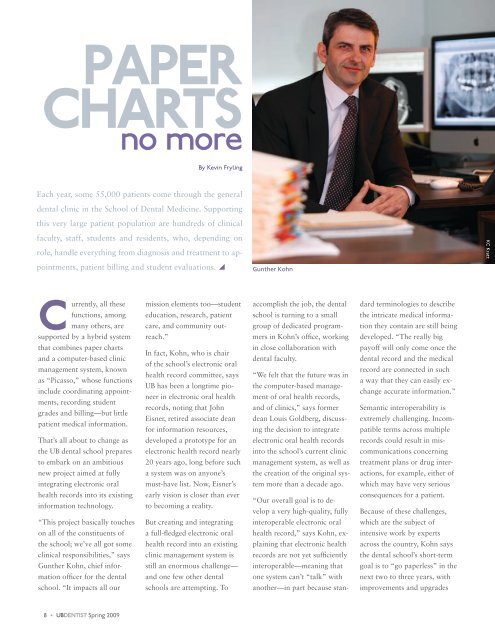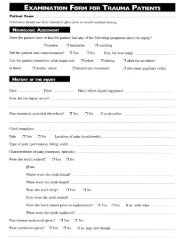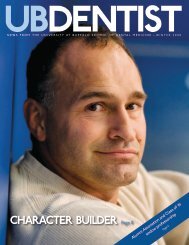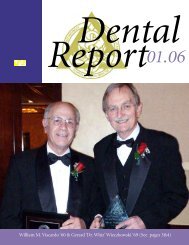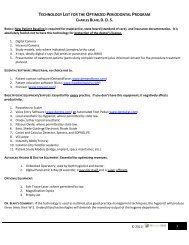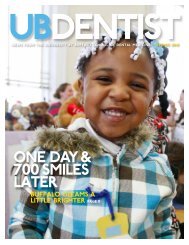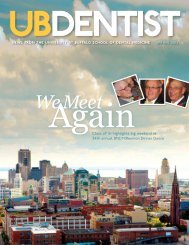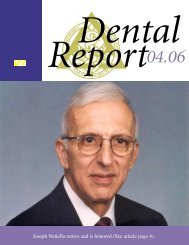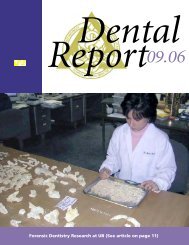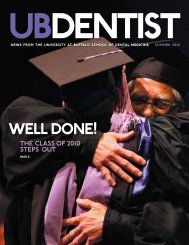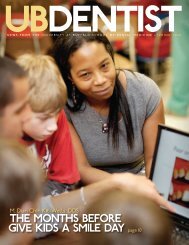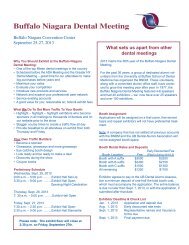Create successful ePaper yourself
Turn your PDF publications into a flip-book with our unique Google optimized e-Paper software.
Paper<br />
Charts<br />
no more<br />
Currently, all these<br />
functions, among<br />
many others, are<br />
supported by a hybrid system<br />
that combines paper charts<br />
and a computer-based clinic<br />
management system, known<br />
as “Picasso,” whose functions<br />
include coordinating appointments,<br />
recording student<br />
grades and billing—but little<br />
patient medical information.<br />
That’s all about to change as<br />
the <strong>UB</strong> dental school prepares<br />
to embark on an ambitious<br />
new project aimed at fully<br />
integrating electronic oral<br />
health records into its existing<br />
information technology.<br />
“This project basically touches<br />
on all of the constituents of<br />
the school; we’ve all got some<br />
clinical responsibilities,” says<br />
Gunther Kohn, chief information<br />
officer for the dental<br />
school. “It impacts all our<br />
8 u <strong><strong>UB</strong>Dentist</strong> spring 2009<br />
by kevin fryling<br />
Each year, some 55,000 patients come through the general<br />
dental clinic in the School of <strong>Dental</strong> Medicine. Supporting<br />
this very large patient population are hundreds of clinical<br />
faculty, staff, students and residents, who, depending on<br />
role, handle everything from diagnosis and treatment to appointments,<br />
patient billing and student evaluations. y<br />
mission elements too—student<br />
education, research, patient<br />
care, and community outreach.”<br />
In fact, Kohn, who is chair<br />
of the school’s electronic oral<br />
health record committee, says<br />
<strong>UB</strong> has been a longtime pioneer<br />
in electronic oral health<br />
records, noting that John<br />
Eisner, retired associate dean<br />
for information resources,<br />
developed a prototype for an<br />
electronic health record nearly<br />
20 years ago, long before such<br />
a system was on anyone’s<br />
must-have list. Now, Eisner’s<br />
early vision is closer than ever<br />
to becoming a reality.<br />
But creating and integrating<br />
a full-fledged electronic oral<br />
health record into an existing<br />
clinic management system is<br />
still an enormous challenge—<br />
and one few other dental<br />
schools are attempting. To<br />
Gunther Kohn<br />
accomplish the job, the dental<br />
school is turning to a small<br />
group of dedicated programmers<br />
in Kohn’s office, working<br />
in close collaboration with<br />
dental faculty.<br />
“We felt that the future was in<br />
the computer-based management<br />
of oral health records,<br />
and of clinics,” says former<br />
dean Louis Goldberg, discussing<br />
the decision to integrate<br />
electronic oral health records<br />
into the school’s current clinic<br />
management system, as well as<br />
the creation of the original system<br />
more than a decade ago.<br />
“Our overall goal is to develop<br />
a very high-quality, fully<br />
interoperable electronic oral<br />
health record,” says Kohn, explaining<br />
that electronic health<br />
records are not yet sufficiently<br />
interoperable—meaning that<br />
one system can’t “talk” with<br />
another—in part because stan-<br />
dard terminologies to describe<br />
the intricate medical information<br />
they contain are still being<br />
developed. “The really big<br />
payoff will only come once the<br />
dental record and the medical<br />
record are connected in such<br />
a way that they can easily exchange<br />
accurate information.”<br />
Semantic interoperability is<br />
extremely challenging. Incompatible<br />
terms across multiple<br />
records could result in miscommunications<br />
concerning<br />
treatment plans or drug interactions,<br />
for example, either of<br />
which may have very serious<br />
consequences for a patient.<br />
Because of these challenges,<br />
which are the subject of<br />
intensive work by experts<br />
across the country, Kohn says<br />
the dental school’s short-term<br />
goal is to “go paperless” in the<br />
next two to three years, with<br />
improvements and upgrades<br />
kc kratt


